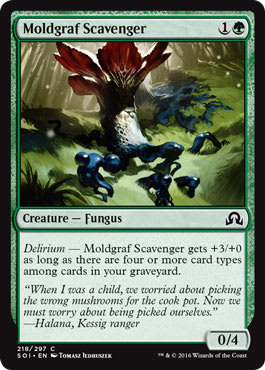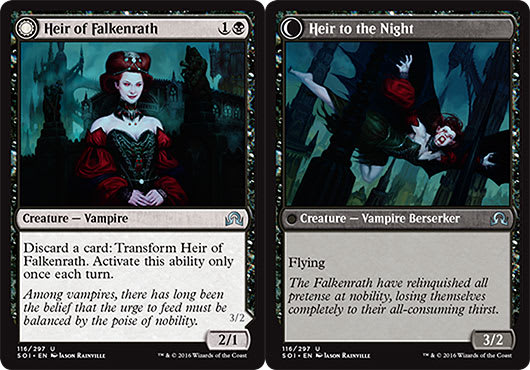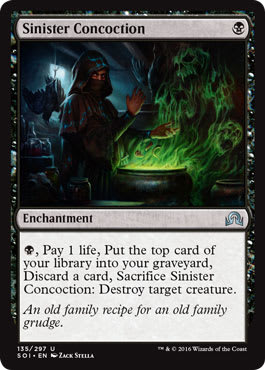As much as I’m a fan of Intro Packs (here’s my defense of them last week), I’ll be the first to admit Shadows over Innistrad’s crop has a few more flaws than normal. Perhaps “flaws” isn’t quite the right way to put it. It’s almost like looking at a laboratory filled with stitched-up Skaabs and seeing mismatched parts all around.
After all, we have one of the stronger Madness cards, Lightning Axe, present in the R/W attacking deck, but not a single copy in the B/R Vampires-and-Madness deck. We have discard outlets like Murderer's Axe and Stern Constable in the R/W attacking deck that don’t have any use for Madness or Delirium, and there are few discard outlets in the subject of today’s Meddling, the G/B Delirium-infused Horrific Visions.
Today, we aim to address that. This is Ertai's Meddling, which sees us take an Intro Pack, strip it down into its core themes and essentials, and rebuild it into an improved version. Like all Meddlings, we follow two essential rules.
First, we can only add cards that were commons or uncommons. With full access to rare and mythic cards, it really becomes something completely different. We want people to be able to tune their decks with the cards they’d have ready access to, either in their collection or easily acquired.
Second, we can only draw upon sets that represented in the Intro Pack I was tuning. “If a set can’t reinforce its theme within the set, then it really isn’t a theme.” Obviously, for Shadows over Innistrad, that means just Shadows over Innistrad, since Wizards discontinued the practice of including Core Set cards in their set-based Intro Packs.
Horrific Visions is unlike almost any other Intro Pack deck I can think of in terms of its intricacy. This is mainly due to the function of the deck’s primary mechanic, Delirium. Delirium is what I call a “min/max mechanic,” not unlike past mechanics like Threshold (its predecessor) and Metalcraft. The idea of these mechanics is fundamentally simple: You put up with playing cards that tend to be somewhat weaker on average, but once a certain condition is met they then become somewhat stronger on average. First the famine, then — if you pull it off — comes the feast! But Delirium is different from other such mechanics in its complexity. You don’t just need seven cards dumped into your graveyard, or three artifacts in play; rather, you need four cards of different types, which requires you to build a deck with a specific balance.
Let’s start with a look at the stock decklist.
Into Pack Horrific Visions ? Shadows over Innistrad Standard | Wizards of the Coast
- Creatures (22)
- 1 Crow of Dark Tidings
- 1 Ghoulsteed
- 1 Hound of the Farbogs
- 1 Inexorable Blob
- 1 Kessig Dire Swine
- 1 Loam Dryad
- 1 Morkrut Necropod
- 1 Soul Swallower
- 1 Wild-Field Scarecrow
- 2 Groundskeeper
- 2 Obsessive Skinner
- 2 Stallion of Ashmouth
- 2 Tooth Collector
- 2 Wicker Witch
- 3 Moldgraf Scavenger
- Spells (13)
- 1 Merciless Resolve
- 1 Might Beyond Reason
- 1 Throttle
- 1 Fork in the Road
- 1 Liliana's Indignation
- 1 Rabid Bite
- 1 Crawling Sensation
- 2 Dead Weight
- 2 Vessel of Nascency
- 2 Explosive Apparatus
- Lands (25)
- 11 Swamp
- 12 Forest
- 1 Foul Orchard
- 1 Warped Landscape
As alluded to in the introduction, there are three ways to “stock the larder” of your graveyard to ensure you hit Delirium.
The first method is by random chance. This is evidenced by cards that mill random cards off the top of your library like Crawling Sensation, Liliana's Indignation, Crow of Dark Tidings, or the clutch Vessel of Nascency. With the latter, it’s certainly possible for you to hit Delirium as early as turn two, but it cannot be relied upon. Sometimes you’ll hit it, sometimes you won’t, it’s all a matter of luck. While Magic is, of course, a game of variance, our objective as players is to minimize that where we can, and make a deck something reliable rather than just a slave to fortunes good and bad.
That brings us to the second way we can attain Delirium — through targeted graveyard-stocking. This is important, because it gives us some ability to be a master of our fates, and explains a number of other cards in the deck. The designer of Wild-Field Scarecrow probably didn’t tell their significant other that they were retiring, because no other work they did from that day forward would be the equal of this masterpiece. But it has a purpose in the deck — to give you the ability to send an Artifact Creature to the graveyard at-will. That’s two of the four card types needed; halfway to Delirium!
The cards in the stock list that do this include Explosive Apparatus, Fork in the Road, and Merciless Resolve. Indeed, this is sort of the ‘default category,’ because you have a wider ability to forge your path here. Need a Sorcery in the graveyard? Rabid Bite gets you there. An Instant? Kill something with Throttle. A creature? Keep attacking your opponent with some and sooner or later, they’ll solve that problem for you (or you’ll win).
These are the two methods espoused by the stock deck, but there is actually a third: discard. No need to wait for the right time to cast a spell here, no need for your opponent to help you along by killing the nettlesome weenie you’ve thrown their way for a few successive turns. Discard is as clinical as it gets — what matters isn’t utility or context, just card type. The stock deck touched on this briefly with the inclusion of Ghoulsteed, who can be fetched back with the discard of two cards.
We’re going to do two things with our rebuild of Horrific Visions. First, we’re going to broaden your ability to impact what’s in your graveyard by offering all three modes of larder-stocking. Second, we’re going to simultaneously tighten Delirium, while making it less of the deck’s focus. That might seem a little quixotic — you’re going to strengthen it by making it weaker . . . ? But the original deck had some blind spots — most notably in the area of being able to remove threats while it tried to stockpile the appropriate cards in the graveyard, and those need to be addressed. Simultaneously, the original list spent a lot of its energy trying to get you to hit Delirium, so you’d be sure to experience the mechanic. We can do that with less, and still bolster the deck’s ability to win even if you don’t manage the trick. That way, you’re less reliant on Delirium, and more seeing it like a ‘zip strip’ that shoots you ahead toward victory.
Breaking it Down
As usual, we’ll start with the scalpel. What do we keep, and what do we cut? First, we’re letting go of our Groundskeeper. Originally printed in Mercadian Masques to give you a way to mitigate the cost of the Spellshapers (creatures which offered you a spell-like effect in return for discarding a card), they’re less useful here. They make a fine hedge for those worried about too much land falling into the graveyard in the hunt for Delirium, but that’s not a problem (or opportunity) sufficient to warrant dedicating cards to.
The Loam Dryad goes with it. We’re not going to be needing any kind of mana ramping, so it’s a dead card here. We’ll also be dispensing with the services of the Obsessive Skinner. This is an interesting card, letting you slowly grow your army once you hit Delirium. It makes for a nice, long-term strategy if you activate it early enough, but it’s also a very weak draw late in the game. It’s the kind of card you want to either go all in on, or cut completely. We’re opting for the latter.
Although the two Artifact Creature offerings here are useful for Delirium, neither of them are especially good on their own. That means in games where you’ve hit Delirium, you’re likely to be wishing you’d have drawn something else. If the best thing going for a creature is that it could help you hit Delirium, it’s a pretty good sign maybe it’s not the best thing for its mana — we’re going to focus more on creatures with added value or effect.
The Stallion of Ashmouth is a mana sink creature, turning into a Shade when you’ve got Delirium up. It takes a continual investment of mana to be useful (like many Shades, it’s a little underwhelming in its natural state). We’re also going to axe the higher end of the creature curve. Our finished deck will be packed with removal, so the attack lanes will be more open to smaller and evasive creatures. Having big fatties is a fun way to win, but again we’re after some mid-curve consistency. That sees off the Ghoulsteed, Hound of the Farbogs, Morkrut Necropod, and Kessig Dire Swine.
So what to replace them with? We’re going to want to keep about the same creature ratio as the stock deck, to make room for other card types. But we can certainly tighten things up.
First, we’re going up to a full playset on the Moldgraf Scavengers. In pre-Delirium, these are very solid 0/4 walls that thicken up the red zone, giving us time to flip the deck’s switch. Once we’ve done so, 2-mana 3/4's are a terrific value. Useful in both modes, these are a no-brainer here.
The other 2-drop will be the Heir of Falkenrath. We’ve seen her before in Meddlings, as it’s a very solid card. In a Madness deck, having a discard outlet is very useful. The same idea applies here for Delirium. Need one last card type to flip the deck’s Delirium switch? Throw it away to transform her, and not only do you get a 3-power evasive upgrade, but you also are activating Delirium at instant speed. Rather than hoping to optimize the deck in time to get the most out of a handful of singleton fatties, the Meddled Horrific Visions is mid-game focused, with an eye for evasive bodies. The Heir checks off all the boxes.
Moving up to the deck’s 3-drops, we begin with the Inexorable Blob. One of the deck’s two rares, it’s a strong card and an obvious keep. We’ll also add three more copies of Crow of Dark Tidings. The Crow is one of the ‘random mill’ cards in the deck, but we still want some of that to maximize our chances for Delirium. It’s fragile as a 2/1, but flying should give it some advantage in dealing damage to your opponent.
We’re also going to max out on the Tooth Collector. This guy is like the Obsessive Skinner and Topplegeist, a card that offers a modest effect that becomes repeatable after triggering Delirium. On its own, it’s a nuisance, but in multiples it can be downright lethal, as repeatable removal is always strong. Even if it doesn’t outright kill things, it can certainly help weaken an opponent’s attack down to a more manageable level, or blunt some incoming damage.
The last card here will be another new face, the Kindly Stranger. This is a clever blending of both the Delirium and dual-faced card mechanics, going from a wizened 2/3 into a very monstrous 4/3. Sure, it costs three mana to transform her once you’ve hit Delirium, but oh what a bonus! The stock deck suffered a great deal from a lack of effective removal. Although her transformed side doesn’t have evasion, 4 power is a solid option. We’ll still want some devoted removal cards in hand, but the Stranger brings some extra kill power to bear.
The final creature here is the Soul Swallower, an excellent choice for a premium rare. If you’ve got Delirium up, it’s swinging for the first time as a 6/6, with the promise of continued growth. We very rarely cut rares from these decks because they’re swingy and fun, even if they don’t always directly impact the theme or strategy we’re aiming for. But this one nails it.
Adding Support
As for the rest of the deck, it’s the usual and customary Intro Pack mish-mash of non-creature cards, a little less consistent than usual because of the nature of the Delirium mechanic. Hitting the nuke button and starting from scratch, we come up with a much more focused spell core that covers the bases of card types.
For instants, we’re going with a full playset of Aim High. The instant selection of these two colors in Shadows over Innistrad is surprisingly thin, and we’ll have enough removal without needing to rely on the pricey Throttle. As a combat trick, Aim High can help sneak in some extra damage, or act as ersatz removal. The fact that its target doesn’t have to be untapped to act as an ‘ambush defender’ seals the deal, since this requires no slowdown on the part of our offense to be valuable.
For sorceries, two copies of Fork in the Road are enough. These fetch us land to the hand as well as the graveyard, and are a solid enabling card. Two may not seem like a lot, but remember the stock list only carried three sorceries.
We bulk up a touch on enchantments, with four copies of Vessel of Nascency and two of that flavor grand-slam, Sinister Concoction. The Vessel of Nascency is a one of the pillars of the deck, replacing itself in your hand for your pick of a creature, land, or enchantment from amongst the top four cards of your library, then seeing the other three off to the graveyard to help build Delirium. It’s a top-shelf enabler, and a card you’ll be particularly delighted to see in your opening hand.
The other enchantment, Sinister Concoction, is another piece of creature removal. It’s a great way to get an enchantment into the graveyard, in addition to a card from your hand and a random one off the top of the library. We don’t want to go too far into self-discard, since that’s a high price to pay at the best of times, but it helps to have that level of control over our progress toward Delirium. Between these and the Heirs of Falkenrath, we should have that angle fairly well covered.
Finally, we’ll be keeping the pair of Explosive Apparatus. A little extra direct damage is always a good thing, and it helps get artifacts into the graveyard. And while we’ll be tinkering with the mana base to match the new deck’s needs, we’re going to be upping the count of Warped Landscapes — one more way to get a land into the graveyard.
Here’s the final list for our Meddled deck!
Meddled Horrific Visions ? Shadows over Innistrad Standard | Jay Kirkman
- Creatures (22)
- 1 Inexorable Blob
- 1 Soul Swallower
- 4 Crow of Dark Tidings
- 4 Heir of Falkenrath
- 4 Kindly Stranger
- 4 Moldgraf Scavenger
- 4 Tooth Collector
- Spells (14)
- 4 Aim High
- 2 Fork in the Road
- 2 Sinister Concoction
- 4 Vessel of Nascency
- 2 Explosive Apparatus
- Lands (24)
- 9 Forest
- 9 Swamp
- 2 Foul Orchard
- 4 Warped Landscape
I hope you’ve enjoyed today’s Meddling. What cards would you have kept? What would you have included? Let me know in the comments below!



































